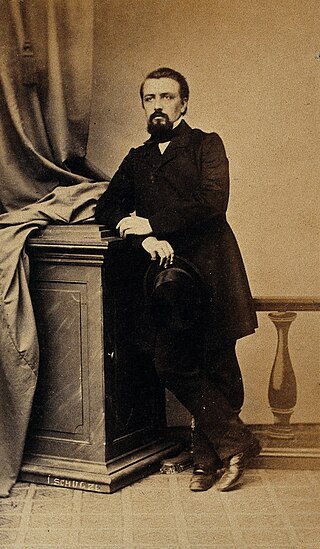
Rudolf Ludwig Carl Virchow was a German physician, anthropologist, pathologist, prehistorian, biologist, writer, editor, and politician. He is known as "the father of modern pathology" and as the founder of social medicine, and to his colleagues, the "Pope of medicine".

Victor Babeș was a Romanian physician, bacteriologist, academician and professor. One of the founders of modern microbiology, Victor Babeș is author of one of the first treatises of bacteriology in the world – Bacteria and their role in pathological anatomy and histology of infectious diseases, written in collaboration with French scientist Victor André Cornil in 1885. In 1888, Babeș underlies the principle of passive immunity, and a few years later enunciates the principle of antibiosis. He made early and significant contributions to the study of rabies, leprosy, diphtheria, tuberculosis and other infectious diseases. He also discovered more than 50 unknown germs and foresaw new methods of staining bacteria and fungi. Victor Babeș introduced rabies vaccination and founded serotherapy in Romania.

Carl Heinrich Auspitz was a Jewish Austrian dermatologist. He was the husband of pianist Auguste Auspitz-Kólar (1843–1878).

Paul Langerhans was a German pathologist, physiologist and biologist, credited with the discovery of the cells that secrete insulin, named after him as the islets of Langerhans.

Charcot–Leyden crystals are microscopic crystals composed of eosinophil protein galectin-10 found in people who have allergic diseases such as asthma or parasitic infections such as parasitic pneumonia or ascariasis.

Friedrich Daniel von Recklinghausen was a German pathologist born in Gütersloh, Westphalia. He was the father of physiologist Heinrich von Recklinghausen (1867–1942).

Julius Friedrich Cohnheim was a German-Jewish pathologist.
Hermann Friedberg was a German physician from Rosenberg (Olesno), Silesia.

Albert Fraenkel was a German physician.

Nikolaus Friedreich was a German pathologist and neurologist, and a third generation physician in the Friedreich family. His father was psychiatrist Johann Baptist Friedreich (1796–1862), and his grandfather was pathologist Nicolaus Anton Friedreich (1761–1836), who is remembered for his early description of idiopathic facial paralysis, which would later be known as Bell's palsy.

Leopold Auerbach was a German anatomist and neuropathologist born in Breslau. He is best known for discovering the myenteric plexus aka Auerbach’s plexus, which helps control the GI tract.

Carl Jakob Adolf Christian Gerhardt was a German internist born in Speyer.

Robert Rössle was a German pathologist. He was born in Augsburg and died in Berlin.

Louis Waldenburg was a German physician.
Rudolf Robert Maier was a German pathologist who was a native of Freiburg im Breisgau.

Felix Victor Birch-Hirschfeld was a German pathologist who was a native of Kluvensieck bei Rendsburg.
Benno Ernst Heinrich Reinhardt was a German physician who worked as prosector at Charité hospital in Berlin. He is known for his contributions to pathology, especially as co-founder of the journal Virchows Archiv.
Arnold Ludwig Gotthilf Heller was a German anatomist and pathologist who was a native of Kleinheubach am Main, Bavaria.
David Paul von Hansemann was a German pathologist born in Eupen, east Belgium. He is remembered for his work in the field of oncology, in particular, his concept pertaining to anaplasia of cancer cells.
Solid cell nests, often abbreviated as SCN, also known as solid cell rests, are specific groups of cells found in the thyroid gland of babies. Typically they are a fraction of a millimeter in size but can rarely become larger. They are considered to be the remains of the ultimobranchial body that exists in early development.













